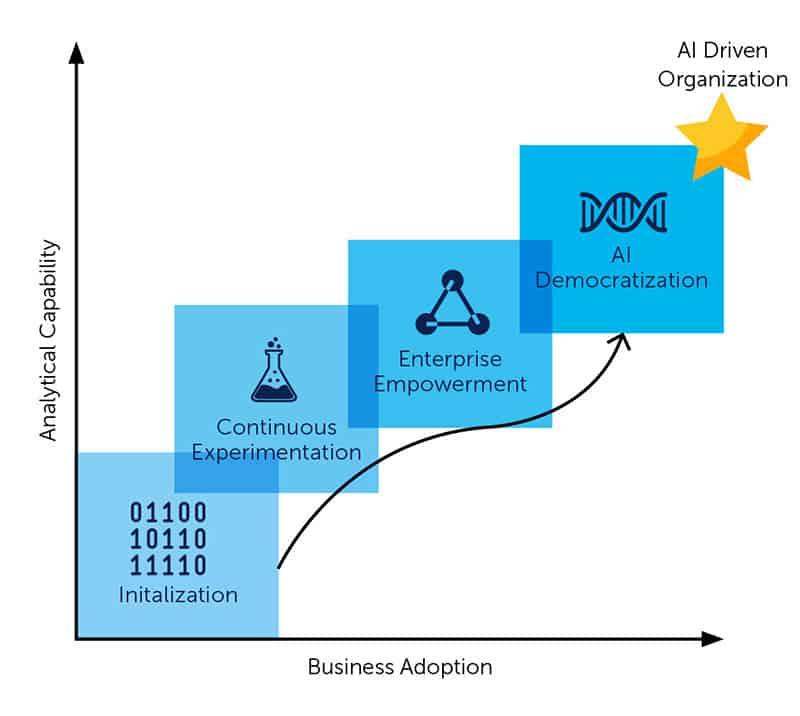The AI Maturity Journey has been developed by Xebia consultant Steven Nooijen. In this interview, he explains how the AI Maturity Journey came about and how businesses can use it.
Hiring data engineers and data scientists and expecting success to follow is like putting a Ferrari engine in a minivan and thinking you will win the F1 World Championship. The reality is very different. In GoDataDriven consultant Steven Nooijen’s experience, “Companies that are fully AI-driven are sparse—I personally haven’t come across any in The Netherlands.”
AI Maturity Journey
Nooijen attended a chief data officer course in 2018, which broadened his perspective on artificial intelligence and how his clients were (and were not) successfully using it. Nooijen recognized certain patterns and decided to pitch an idea to his fellow GoDataDriven consultants—the AI Maturity Journey. “I asked them if they recognized the patterns, and most of them did,” he explained.
“So, we plotted some of our GoDataDriven clients in an early version, which went surprisingly well. It confirmed our notion that most organizations follow a similar path in maturing their AI practice,” he said. Through conversations with clients, Nooijen validated his findings further and then set to work on developing his concept.
Analytical and Business Capability
The AI Maturity Journey features two axes, analytical capability, and business adoption. The first focuses on more “traditional” elements related to the success of data and AI— people and skills, tools and technology, and data.
“When I started as a data science consultant around five years ago, everyone was focused on capturing as much data as possible— creating different forms of data lakes and hiring data scientists,” explained Nooijen. “Of course, you need these elements, but over time it has become obvious that this is not enough to create valuable AI products.
For AI solutions to be successful, the business needs to change. That is not something a scientist or an engineer can do. Business capabilities cannot sufficiently evolve without management buy-in for improving AI maturity,” he explained.
Common Mistakes on Both Sides
Nooijen and his colleagues regularly spot the pitfalls for organizations while working on-site with them.
“On the analytical side, data quality and governance are still an issue. If you have bad quality data as input, the output can never be good. And, if no one is assigned data ownership of a bad source, there is no chance that the quality will ever improve,” he explained.
“Another issue is hiring. Often there are no lead or senior engineers or scientists to really judge the quality of new hires. When you have an applicant that is able to sell him- or herself well but writes bad code, that’s often not caught by the interviewers. It leads to situations where consultants coming in to enhance AI maturity have to tell the client that their ‘senior’ data scientists are actually junior or mid-level, at most.”
Nooijen has seen situations where 70% of data scientists were external—which makes it impossible to establish good ways of working or to achieve consistency.
“Data scientists have to get out of their coding bubble and create applications that the business wants,” he continued. “Because business users often lack the knowledge to know what’s possible with data and AI, the value isn’t realized. Solutions aren’t (properly) productized, there are no checks to validate value generation, and monitoring of value creation is non-existent,” he explained.
Maturing Your AI Capabilities
Maturing your organization’s AI capabilities requires work from two sides. The analytical capability is best enhanced from the bottom-up, while the business adoption aspect needs to be improved top-down. Nooijen recommends setting up chapters for data engineers and scientists. A chapter helps create a standard way-of-working and improves knowledge sharing, which boosts the quality of AI solutions across the board.
He explained that business adoption issues require a top-down approach: “Management needs to embrace data and AI as a central part of the company’s strategy. When both analytical and business capability matures at the same time, it will steer a company towards better results. However, there is still a hurdle to overcome. You have to bring together the analytical and business side. If an AI solution isn’t adopted by business users or doesn’t generate value, it’s a waste of money.”
According to Nooijen, the cure for this problem is education and designating people to bridge that gap: “You need to educate business users on the possibilities of AI solutions, at the same time the data and AI teams need to learn how to talk to the business. Bridging that gap is an ideal role for analytics translators, also known as data science product owners, or business translators. These roles bring data science and business together.”He continued, “It mostly comes down to making use of and adhering to a framework. You should build stage gates that ensure ideas provide value before they progress to the next phase. If you want to get data scientists to talk to the business, you need to physically bring them together and let them work next to each other. Daily stand-ups and biweekly demos are also great tools to ensure successful products. It’s what Agile was designed to do.”
Providing Insights With the AI Maturity Scan
Based on the AI Maturity Journey, Nooijen and his GoDataDriven colleagues developed the AI Maturity Scan. This scan plots an organization’s analytical and business capability and shows where improvements can be made.

Nooijen explained how it works:
We developed the scan, because we saw clients in several phases of the AI Maturity Journey struggling with how to further develop their AI capabilities
Because the path to AI maturity is relatively similar for most organizations, the scan is a great way to get reliable insights quickly. It works for organizations in all phases of AI maturity, whether you have a team of eight to ten people doing data science and want to involve the business, or if you are already beyond that and want to become fully AI-driven.
We executed the scan at several organizations and discovered that there is generally a hunch about the outcome. But a big surprise is often the knowledge level of the data teams, where people are in mid-level or senior roles, but their coding is not at that level.
The scan has also opened the eyes of people at some organizations. One organization had tried to hire a lead data scientist twice, but both times this person left within three months. That should be a signal that something is not quite right. The scan revealed the underlying issues and provided advice on how the organization could improve.
The scan is an excellent starting point to improve data and AI capabilities. One of our clients decided not to hire any additional external staff and to focus first on improving their internal capabilities, based on the results of our scan. We helped them create a data science chapter and standardized their ways of working, recruitment processes, and knowledge sharing. Within a year, they had made impressive progress. The scan helped direct these improvements, and the clients valued the results.





